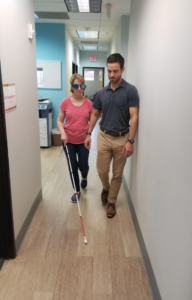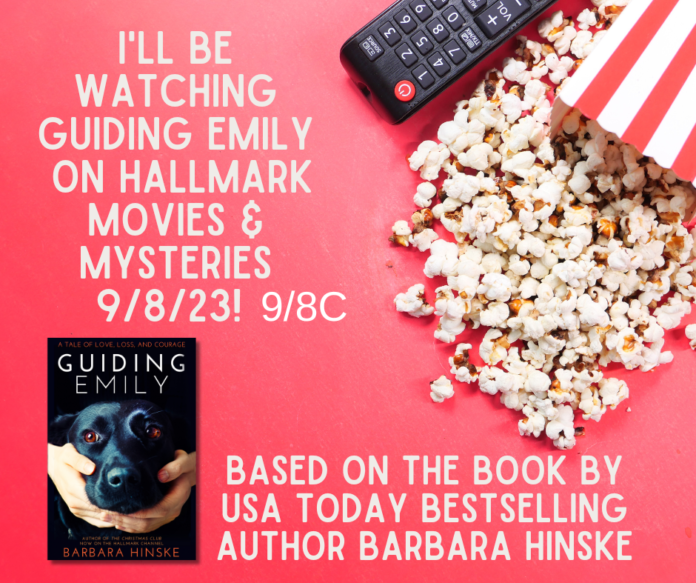GUIDING EMILY BY BARBARA HINSKE
(TUNE IN SEPT 8TH TO HALLMARK)
Today, we welcome author Barbara Hinske and get a look behind the scenes of this amazing book, and now Hallmark movie.
The Inspiration
Have you ever heard a story that changed your life?
Within thirty minutes of stepping through the Foundation for Blind Children’s doorway, my life found its new purpose and mission.
I’ve lived down the street from The Foundation for Blind Children for decades. I’d never been inside. The Foundation’s Development Director, Steve Pawlowski, encouraged my husband and I to come for a tour with such enthusiasm and pride that we felt we couldn’t decline.
The Foundation provides education, tools, and services for “children” from birth through one hundred and four. From observing teachers working one-on-one with students with multiple disabilities, to seeing the six-year-old child from Canada running and hugging staff even though his parents had been told by their Canadian doctor he would never walk or talk, to photos displayed on the wall of the group of blind teens and young adults who had climbed Mount Kilimanjaro, I was moved beyond measure.
Choking back tears, I asked Steve how I could help. What did the Foundation need? His answer was simple and straightforward: (1) funding, and (2) to raise awareness of problems that visually impaired people face within the sighted community.
I’m an author and knew that a novel could address both of these issues. The story line of my new series was born in that moment.
Guiding Emily is the first book in a series and is a love story between Garth, a guide dog, and Emily Main, his handler who loses her eyesight on her honeymoon. It’s the
heartwarming/heartbreaking/poignant tale of their journey together.
Half the profits from Guiding Emily will be donated to The Foundation for Blind Children. For the price of a book, every reader receives a novel that will provide a welcome respite from daily life and supports a remarkable organization that believes vision loss is a diagnosis, NOT a disability. What could be better than that?
White Cane Training
What would you do if you lost your eyesight? This is a very real question for more than fifty thousand Americans each year. One thing you’d need to learn is how to use a white cane.
As part of my research for my new novel, Guiding Emily, I took white cane training. Spencer Churchill, an orientation and mobility instructor at The Foundation for Blind Children, fitted my cane and provided me with a pair of goggles that had been blacked out, leaving only a pinhole of vision in the center of the left eye. These glasses replicated the usable vision of many blind people, he told me. I was able to discern light and dark and had clear vision in that tiny circle.
 This wasn’t too bad, I thought. I could move my head around and find my way. Spencer later told me that many blind people try to cope with their restricted vision this way. As I soon found out, it doesn’t work. Swinging my head as rapidly as needed to walk fluently was ineffective and left me dizzy and headachy.
This wasn’t too bad, I thought. I could move my head around and find my way. Spencer later told me that many blind people try to cope with their restricted vision this way. As I soon found out, it doesn’t work. Swinging my head as rapidly as needed to walk fluently was ineffective and left me dizzy and headachy.
Spencer had me put my left hand on his right elbow. We stepped out of his office and took one spin up and down the hall, with Spencer acting as my sighted guide. I knew there were no obstacles in my path and I was being led by an instructor who wouldn’t let anything happen to me. I could always pull off the goggles, too.
Still, the experience was unnerving. I took deep breaths to settle myself.
Next, Spencer instructed me on the back and forth sweeping motion of the cane. The tip of the cane sweeps to the spot where the foot will go. I got the hang of it. The tip of the cane is also used to explore doorways and changes in elevation, like steps and curbs. We tried that, too.
I learned that many blind people compensate for their lost vision by counting steps from object to object within their own homes. That method of coping takes a person no farther than their own front door. He showed me how to locate a landmark (the huge copy machine) and remember destinations from there (three doorways to his office, two to the ladies room). I was still trying to cheat and use my pinhole of usable vision. I became hyper aware of my body in space. It felt like the air was pushing in on my shoulders
We then went outside to the quiet sidewalk that ran along the building. The busy main road was nowhere near us. I walked up and back with my cane, Spencer showing me how to recognize and navigate curbs. We explored the truncated domes in the concrete that signal an entrance to a street. He was at my side the entire time and I knew, intellectually, that I was completely safe. Sweat soaked my collar on this cool spring day. I was panic stricken.
Proficiency in the use of a white cane is essential for people who are blind. I had enough of an introduction to it to believe that it is doable and to appreciate how much courage and practice it takes to master this skill.
The Foundation for Blind Children provided me with invaluable support in my research. I interviewed many of the staff members and clients. I will never forget the newly-blind adults who shared their mental and emotional journeys in the process of regaining their independence.
When people talk of courage, I think of them.
To Spencer and all of the other instructors and counselors who work with the visually impaired to restore their independence:
You improve lives in immeasurable ways.
You have my unending admiration and respect.
MAKE SURE TOHECK BACK WEDNESDAY, SEPTEMBER 6TH WHEN WE WILL HAVE MORE BEHIND THE SCENES DETAILS AND……….PUPPIES!!!!






